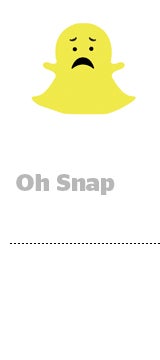Snap’s hotly contested app redesign had a material negative impact on revenue, the company said in its Q1 earnings report Tuesday.
Revenues for the quarter were up 54% year over year to roughly $231 million, but sequentially, they were down 19%, “primarily due to seasonality and our redesign,” the company said in its earnings release.
Daily active users were up 15% year over year, from 161 million to 191 million but just 2% since last quarter. Snap ended the month of March with a lower daily active user number than the 187 million it reported in December, but CEO Evan Spiegel declined to break out the number.
Average revenue per user also took a hit, up 31% year over year to $1.21 but down 21% since last quarter.
Snap’s stock was down 15% in after-hours trading.
Its redesign, released in February, has suffered an unusually harsh backlash from users. Celebrities like Kylie Jenner have publicly tweeted their disdain for it, causing Snap’s stock to plummet 6.1% in a single day. The tone was so sour that some advertisers pulled back spend, Snap’s chief strategy officer, Imran Khan, said on the call.
Ad revenue grew 62% year over year to $229 million, a more robust pace than overall revenue. And its full-screen vertical video Snap Ads were a particular strength, with 102% growth. Still, Snap Ads, which drive the bulk of the business, were down 6% sequentially, Khan said. And lenses and filters, Snap’s most premium ad products, were “challenged by a negative market narrative” around the redesign, he added.
“During the quarter, we had many conversations with our advertisers about the redesign,” he said. “These have been challenging conversations, as we made the proactive and deliberate decision to prioritize our long-term consumer product goals over our short-term monetization goals.”
Beyond the redesign, Snap flipped back to a familiar narrative of blaming programmatic for a 65% drop in ad prices for Snap Ads and a 37% drop in prices for lenses and filters. Snap Ad impressions excluding Story Ads were up 450% year over year and 15% sequentially, thanks to the growth of its auction.
The pricing drop “represents the change in our selling method,” said CFO Drew Vollero on the call.
“Right now, the key activity we’re focused on is bringing advertisers to the platform. We need a broader base using our product. And we’re very focused on ROI,” relative to short-term price drops, he said.
Buyers Still Love It
Despite a tough quarter, Snap had some bright spots in its ad business.
Big brands have always loved Snap because of its unique creative canvas and attention from young audiences. McDonald’s, for example, has tripled its investment on Snap since last year and is pushing out multiproduct ads on the platform for every new campaign.
Advertisers like Adidas, Clairol, Unilever and P&G are testing new ad products and measurement solutions from Snap, like its shoppable AR ads and a reach and frequency measurement tool, Khan said.
“We’re seeing great success with a lot of the large advertisers,” he said. “Snap has gone from being a platform McDonald’s would leverage periodically to an always-on, long-term partner.”
Snap is doing well with performance and small business buyers too. Snap grew its SMB business 30% for the quarter through the rollout of its self-serve platform. The platform was able to increase swipe rates on story ads 14% overall and 8% for the quarter on campaigns optimized for swipes, Khan said. Average cost per install and cost per swipe were half the price they sold for in Q1 in the US, Spiegel added.
Despite a clunky redesign, Snap helped advertisers make progress in engaging with users. Story ads (previously called promoted stories) were watched for an average of 20 seconds since they were launched in June. Average daily engagement on the platform is 30 minutes.
But as Snap grows, it has new issues to confront, like brand safety. In March, an inappropriate ad featuring Rihanna and promoting domestic violence caused widespread backlash around Snap and concerns over its ability to police content.
“At the end of the day, advertisers are rational,” Khan said. “At the same time, they are human. When there’s a lot of negative news every day, it does give people pause. It does influence people’s buying decisions. It does become a distraction on the selling process.”














